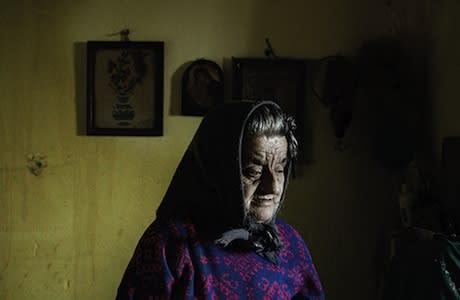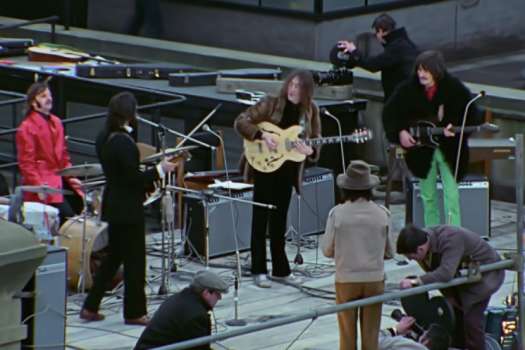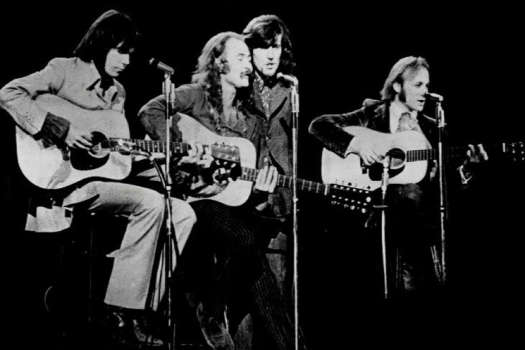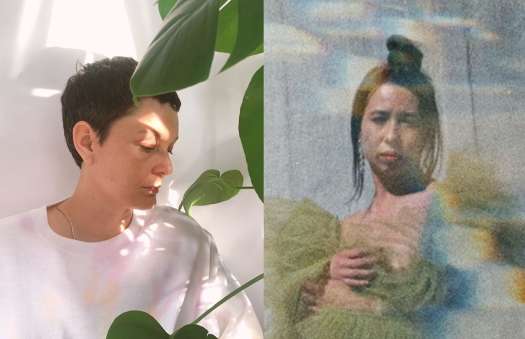Shot over two years, utilizing non-actors that reside within the Greek countryside To the Wolf depicts, Aran Hughes and Christina Koutsospyrou's feature debut, a darkly comic drama with documentary elements, is very much a work of careful consideration. Each composition, drenched with greys and blacks, tells a story unto itself, working as a piece of visual artistry, reiterating the thematic trajectory and sense of despondence present within the loosely defined, ultimately tragic, narrative.
Two families living in the mostly abandoned Nafpaktia Mountains in rural Greece are teetering on the edge of the economic void. Amidst the perpetual grey skies and exquisitely framed, mostly static shots of goat-herding, television discussion and drunken rants denote the repercussions of corporate greed, denoting the realities of pensions being cut to pay for the mistakes of those in positions of power.
These families, spending what little they have left of their savings, unable to sell their goats and racking up debts at the few nearby shops, function within the vacuum of futility, demonstrating no visible hope of financial or social recovery. Aware that they're far enough removed from the populous and the situation—one that their children, who have long-since left the countryside, are currently in the midst of—to be considered or even acknowledged as end point victims, their quiet days of herding, drinking and occasionally engaging in polemical discussions at the local pub have a funereal, increasingly fatalistic, feel.
Hughes and Koutsospyrou refrain from making To the Wolf a traditional admonitory. Each protracted shot frames a character or a situation without clear beginning or end, capturing dialogue and movement as much as it does the uncomfortable silence in between. Though financial concerns ("I could buy two beers for the price of this pack of cigarettes" are verbalized frequently, the solemn expressions and tendency towards vice rather than rationing and planning, create a mood, as does the constant use of shadows indoors and the carefully selection outdoor photography, revealing grey skies at every moment.
This washed out quotidian experience overlooking an endless array of treed mountains serving as a backdrop, reiterates the sense of isolation and abandonment these people feel. With shots lingering on moments long after their superficial intentions have been clarified, these details—the feeling and experience of this space and this life—become as much a character as the slowly starving animals and people quietly awaiting their own fate.
Since this all feels observed and has an air of utmost authenticity (save a couple of structural contrivances), the eventual resolution, one stemming from repressed rage and anguished futility, jolts the system. It's as though Hughes and Koutsospyrou have deliberately and subverted the sense of safety that a documentary, free from extreme dramatic shifts or heightened moments of stylistic contrast, generates, exploiting our complacency and comfort in narrative form by shifting it unexpectedly to hyperbolize the sense of anguish felt in a climate of economic implosion. In short,
This calculated sensibility and consciousness of viewer complacency gives The the Wolf more integrity than it might have otherwise, being ostensibly a slightly pretentious nod to status quo observation with a touch of granola naturalness—using local non-actors—to give it a bit of self-satisfaction a du rigueur superiority. Fortunately, it's also beautifully photographed and exceptionally considered, making the nouveau political posturing, as well-intentioned as it might be, easier to swallow.
(Linel Films)Two families living in the mostly abandoned Nafpaktia Mountains in rural Greece are teetering on the edge of the economic void. Amidst the perpetual grey skies and exquisitely framed, mostly static shots of goat-herding, television discussion and drunken rants denote the repercussions of corporate greed, denoting the realities of pensions being cut to pay for the mistakes of those in positions of power.
These families, spending what little they have left of their savings, unable to sell their goats and racking up debts at the few nearby shops, function within the vacuum of futility, demonstrating no visible hope of financial or social recovery. Aware that they're far enough removed from the populous and the situation—one that their children, who have long-since left the countryside, are currently in the midst of—to be considered or even acknowledged as end point victims, their quiet days of herding, drinking and occasionally engaging in polemical discussions at the local pub have a funereal, increasingly fatalistic, feel.
Hughes and Koutsospyrou refrain from making To the Wolf a traditional admonitory. Each protracted shot frames a character or a situation without clear beginning or end, capturing dialogue and movement as much as it does the uncomfortable silence in between. Though financial concerns ("I could buy two beers for the price of this pack of cigarettes" are verbalized frequently, the solemn expressions and tendency towards vice rather than rationing and planning, create a mood, as does the constant use of shadows indoors and the carefully selection outdoor photography, revealing grey skies at every moment.
This washed out quotidian experience overlooking an endless array of treed mountains serving as a backdrop, reiterates the sense of isolation and abandonment these people feel. With shots lingering on moments long after their superficial intentions have been clarified, these details—the feeling and experience of this space and this life—become as much a character as the slowly starving animals and people quietly awaiting their own fate.
Since this all feels observed and has an air of utmost authenticity (save a couple of structural contrivances), the eventual resolution, one stemming from repressed rage and anguished futility, jolts the system. It's as though Hughes and Koutsospyrou have deliberately and subverted the sense of safety that a documentary, free from extreme dramatic shifts or heightened moments of stylistic contrast, generates, exploiting our complacency and comfort in narrative form by shifting it unexpectedly to hyperbolize the sense of anguish felt in a climate of economic implosion. In short,
This calculated sensibility and consciousness of viewer complacency gives The the Wolf more integrity than it might have otherwise, being ostensibly a slightly pretentious nod to status quo observation with a touch of granola naturalness—using local non-actors—to give it a bit of self-satisfaction a du rigueur superiority. Fortunately, it's also beautifully photographed and exceptionally considered, making the nouveau political posturing, as well-intentioned as it might be, easier to swallow.




